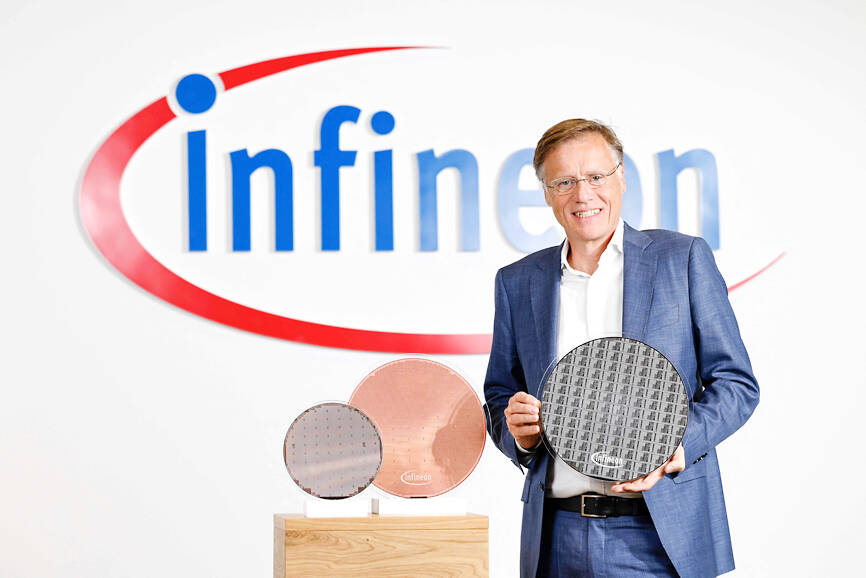Infineon Technologies AG shares rose after the German chipmaker said a hit from tariffs in the fourth fiscal quarter would be less than it anticipated and it forecast better-than-expected margins this year as the industry recovers from several quarters of depressed demand.
Infineon Chief executive officer Jochen Hanebeck said the company’s forecast in May — that tariffs would contribute to a 10 percent revenue reduction in the period — was too pessimistic.
The impact for the quarter ending next month “will be less pronounced than expected,” Hanebeck said on a call with reporters after the company’s financial results were released yesterday.

Photo: AFP
Profitability is also set to improve. Infineon raised its outlook for its segment result margin to a “high teens” percentage from “mid teens” for the year. The company also slightly raised the forecast for its adjusted gross margin in the fiscal year to at least 40 percent, from about 40 percent previously.
Infineon shares had risen 3.9 percent to 35.06 euros at 9:55am in Frankfurt trading. The stock has gained about 11 percent this year.
The industry is starting to recover from a supply glut that depressed sales for the past several quarters, blunting the impact of global trade issues, such as tariffs and a weaker US dollar.
Hanebeck said that while the oversupply is easing, “we and our customers are continuing to navigate our way through an uncertain macroeconomic and geopolitical situation.”
Still, Hanebeck said at an event at the company’s Dresden site with German Minister for Economic Affairs and Energy Katherina Reiche on Monday that some investments, particularly in the automotive industry, are being held back due to trade tensions.
Europe’s semiconductor industry is assessing the impact of tariffs, which were set at 15 percent following a trade agreement between the US and EU last week.
Revenue in the period ending next month would be flat from a year earlier at about 3.9 billion euros (US$4.5 billion), Infineon said in the statement.
That compares with an average analyst estimate of 4 billion euros, according to data compiled by Bloomberg.
The company expects revenue for the current fiscal year of 14.6 billion euros, compared with 14.96 billion euros last year.
Infineon previously said that revenue would be slightly lower this year.
There is a risk that demand might soften after some customers built up inventories before the levies were announced.
Texas Instruments Inc executives last month said they saw strong orders early in the second quarter, which then returned to more normal levels.
“While overall revenue trends are slightly below our and the market’s expectations, we believe this is mainly due to tariff uncertainty in the US and some signs of weakness in the Chinese car market,” Jefferies Group LLC analysts Janardan Menon and Om Bakhda wrote in a reaction to the results. “With tariff uncertainty subsiding, we remain positive on the cyclical and structural growth outlook, and further margin recovery.”

WEAKER ACTIVITY: The sharpest deterioration was seen in the electronics and optical components sector, with the production index falling 13.2 points to 44.5 Taiwan’s manufacturing sector last month contracted for a second consecutive month, with the purchasing managers’ index (PMI) slipping to 48, reflecting ongoing caution over trade uncertainties, the Chung-Hua Institution for Economic Research (CIER, 中華經濟研究院) said yesterday. The decline reflects growing caution among companies amid uncertainty surrounding US tariffs, semiconductor duties and automotive import levies, and it is also likely linked to fading front-loading activity, CIER president Lien Hsien-ming (連賢明) said. “Some clients have started shifting orders to Southeast Asian countries where tariff regimes are already clear,” Lien told a news conference. Firms across the supply chain are also lowering stock levels to mitigate

IN THE AIR: While most companies said they were committed to North American operations, some added that production and costs would depend on the outcome of a US trade probe Leading local contract electronics makers Wistron Corp (緯創), Quanta Computer Inc (廣達), Inventec Corp (英業達) and Compal Electronics Inc (仁寶) are to maintain their North American expansion plans, despite Washington’s 20 percent tariff on Taiwanese goods. Wistron said it has long maintained a presence in the US, while distributing production across Taiwan, North America, Southeast Asia and Europe. The company is in talks with customers to align capacity with their site preferences, a company official told the Taipei Times by telephone on Friday. The company is still in talks with clients over who would bear the tariff costs, with the outcome pending further

Six Taiwanese companies, including contract chipmaker Taiwan Semiconductor Manufacturing Co (TSMC, 台積電), made the 2025 Fortune Global 500 list of the world’s largest firms by revenue. In a report published by New York-based Fortune magazine on Tuesday, Hon Hai Precision Industry Co (鴻海精密), also known as Foxconn Technology Group (富士康科技集團), ranked highest among Taiwanese firms, placing 28th with revenue of US$213.69 billion. Up 60 spots from last year, TSMC rose to No. 126 with US$90.16 billion in revenue, followed by Quanta Computer Inc (廣達) at 348th, Pegatron Corp (和碩) at 461st, CPC Corp, Taiwan (台灣中油) at 494th and Wistron Corp (緯創) at

NEGOTIATIONS: Semiconductors play an outsized role in Taiwan’s industrial and economic development and are a major driver of the Taiwan-US trade imbalance With US President Donald Trump threatening to impose tariffs on semiconductors, Taiwan is expected to face a significant challenge, as information and communications technology (ICT) products account for more than 70 percent of its exports to the US, Chung-Hua Institution for Economic Research (CIER, 中華經濟研究院) president Lien Hsien-ming (連賢明) said on Friday. Compared with other countries, semiconductors play a disproportionately large role in Taiwan’s industrial and economic development, Lien said. As the sixth-largest contributor to the US trade deficit, Taiwan recorded a US$73.9 billion trade surplus with the US last year — up from US$47.8 billion in 2023 — driven by strong